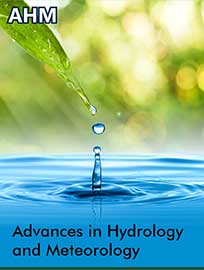 Case Report
Case Report
Hydrogeology in Bizkaia: A study case
Alegria N1*, Penalva I1, Silveiro A2, Pinto C3 and Legarda F1
1Energy Engineering Department, Faculty of Engineering, University of the Basque Country, Spain
2Ingider, Spain
3Department of Mechanical Engineering, Faculty of Engineering, University of the Basque Country, Spain
Alegria N, Energy Engineering Department, Faculty of Engineering, University of the Basque Country, Spain.
Received Date: July 28, 2022; Published Date: August 24, 2022
Abstract
Bizkaia does not have big reservoirs and water needed for the different uses comes from water transfers to a great extent. In fact, more than 90 % of the water used in this province that belongs to the Community of the Basque Country is transferred. Water in Greater Bilbao is basically supplied by the water transfers from River Zadorra (70-80 %) and from River Ordunte (20-30 %). In order to complete the water inventory in this region and improve the water supply system, the existence of groundwater resources has been studied. Due to the geomorphological features of the ground, this zone is not fit for groundwater storage and, as a result, if Bizkaia need a bigger volume of water, this should be transferred or, alternatively, desalination should be considered as a possibility, with all the consequences that this option implies.
Keywords:Groundwater; Hydrogeology; Aquifer; Water transfer; Natural spring
Introduction and Objectives
Bizkaia is one of the three provinces that belong to the Autonomous Community of the Basque Country, washed by the Cantabrian Sea in the north and located between the provinces of Cantabria, Burgos, Araba and Gipuzkoa. Figure 1 shows the location of Bizkaia in Spain.
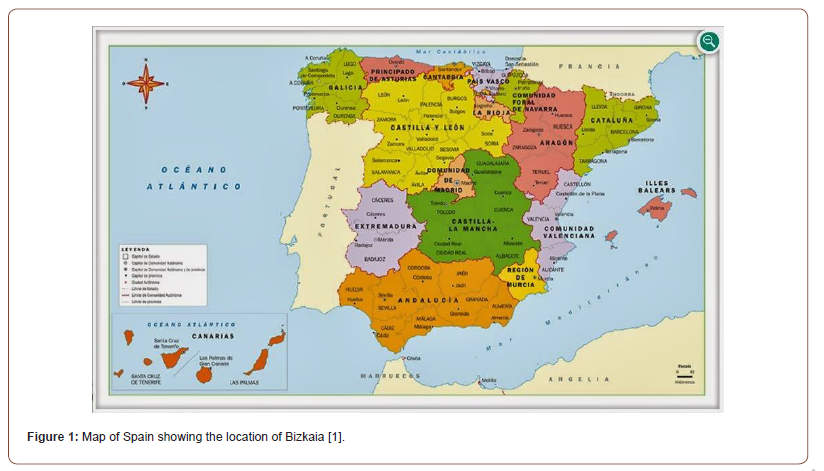
Bizkaia is the only province in Spain that has almost no water at all collected in superficial reservoirs [2], although its average annual rainfall is higher than 1100 mm [3,4]. This is due to the fact that the orography and the big population centers that are located in that region have historically avoided water storage for the different required uses of that area.
Two big water transfers, one coming from the province Araba and the other one from the province of Burgos Legarda F, et al. [5], provide 90 % of the water to Bizkaia. There are some areas in Bizkaia, such as Busturialdea, that depend on the flow rate of the rivers of that region for their water supply [6]. This can imply some water restrictions from time to time, mainly during summer periods when there it does not rain as much as usual.
The objective of this work it to study if the province of Bizkaia has groundwater resources in order to take an inventory of the available water and set out its possible uses.
Development of the work
It is well known that in Bizkaia, in the region of Durango, the aquifers of Mañaria and Arrobia are joggled together with the surface waters of the Oiz massif [7] (catchment of Sarria where a Hydraulic Power Plant is placed). However, a complete analysis of the province of Bizkaia will be carried out.
Taking as a baseline the data provided by the Geological and Mining Institute of Spain (Instituto Geológicoy Minero de España (IGME)), which is a public research institute assigned to the Ministry of Science and Innovation (Ministerio de Ciencia e Innovación (MICINN)), the cartography related to Bizkaia has been analyzed [8]. Figure 2 shows the map for the whole Iberian Peninsula [9] and Figure 3 shows the information shown when trying to get information related to Bilbao and its surroundings [10].
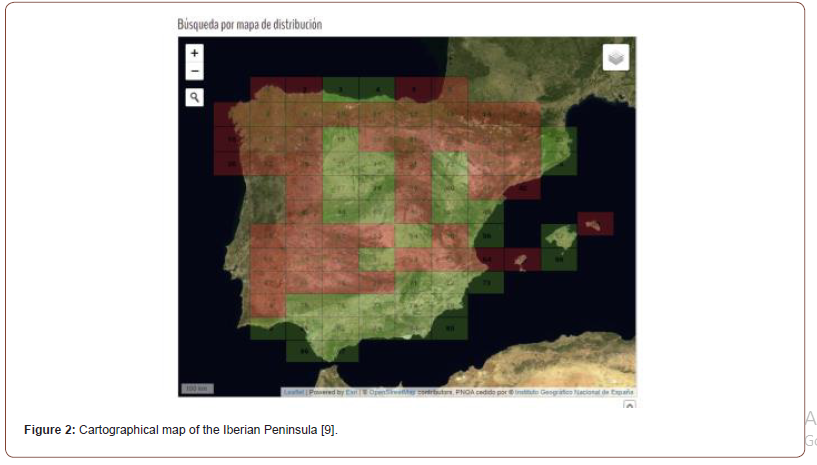
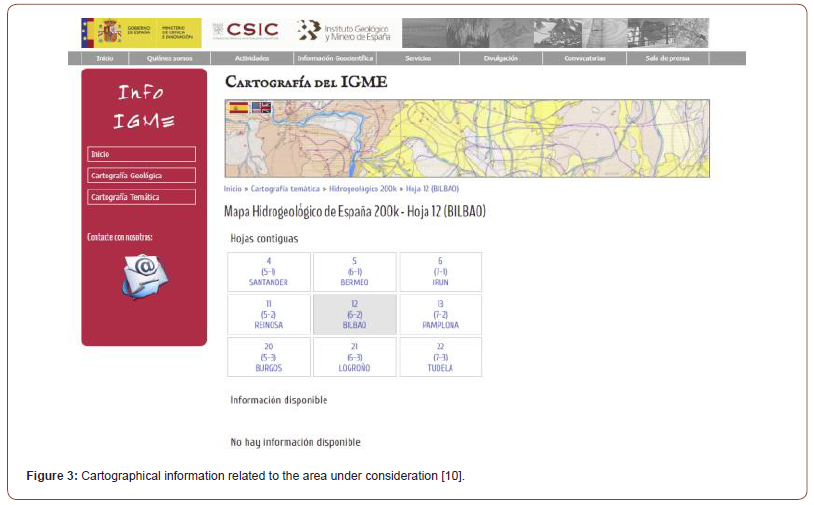
As long as there is not enough information for this region currently in this source to develop the study, a new search for data has been carried out in the database of Points of Water of the IGME [11]. In this case, information related to two sources has been found (water sounding and natural spring). That information is shown in Tables 1&2.
The information shown in Tables 1&2 refer to individual points that have been analyzed. For each point, different information is provided, such as elevation, depth, uses, and so on. Figure 4 shows an example of the information provided for one of these points, Larrabezua.
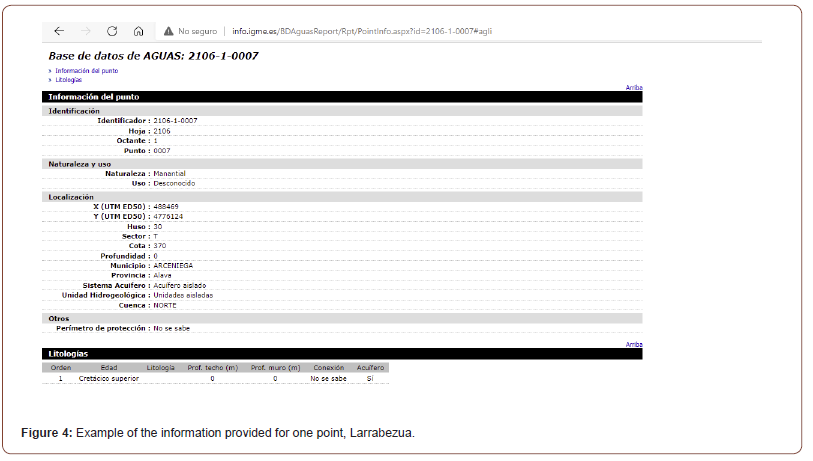
Table 1: Information related to groundwater by means of soundings.
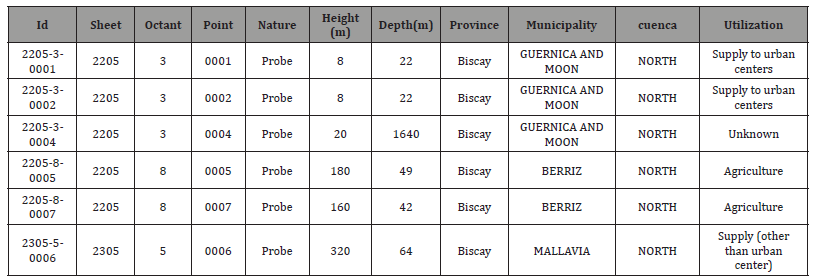
Table 2: Information related to groundwater by means of natural springs.
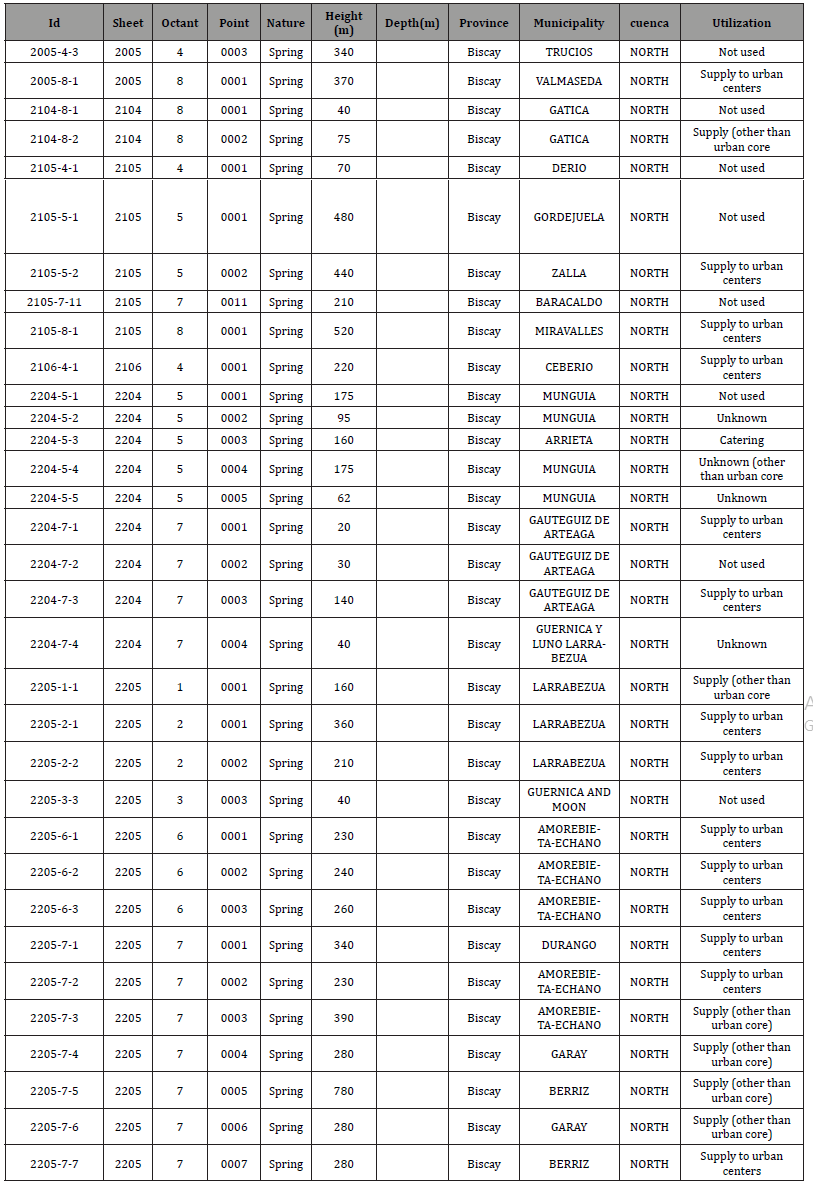
According to all the information gathered, different types of water supplies have been identified. Table 3 shows the summary for total inventory of these types.
The software ARGIS [12] has been used and the maps with the hydrogeological information have been downloaded (Figure 5) [13] together with the values of the permeability (Figure 6) [14]. Considering all these data, it can be concluded that Bizkaia is not a region with a significant groundwater storage capacity.
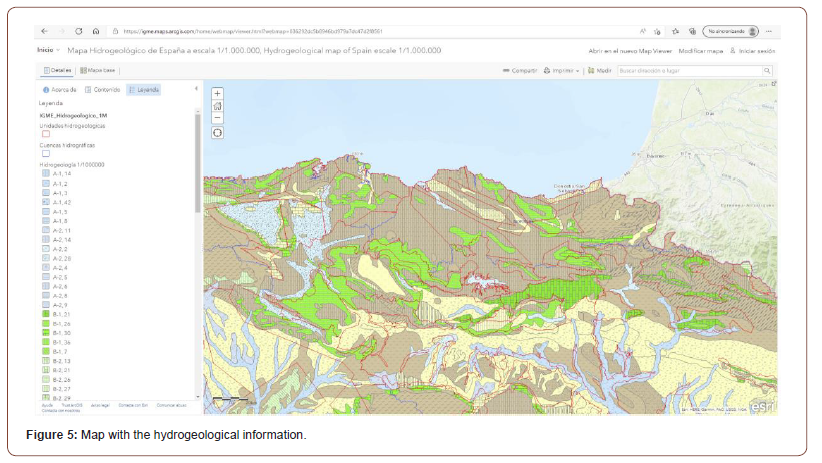
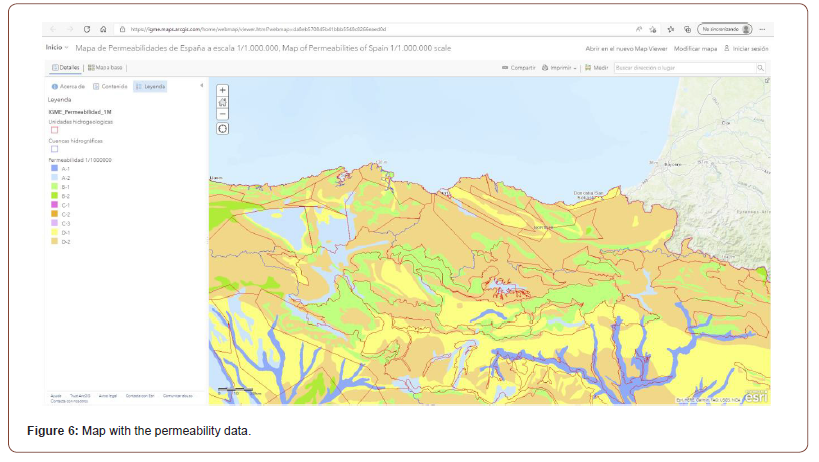
Table 3: Summary of the total inventory of groundwater in Bizkaia.
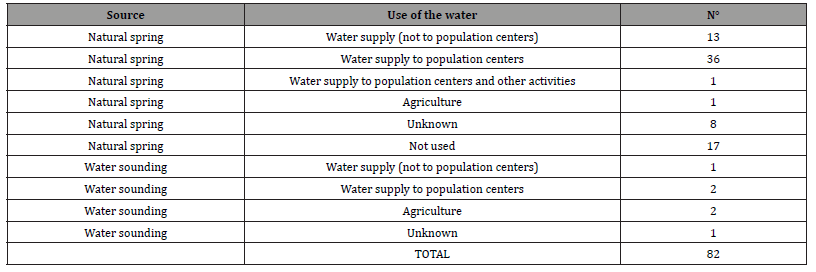
Bizkaia is located in the Cantabrian Coast and the management of the water corresponds to the Cantabrian Hydrographic Confederation [15]. This institution provides information related to the hydrogeology of the region. Among the 34 masses of groundwater that are identified, only 5 of them are in Bizkaia (Figure 7).
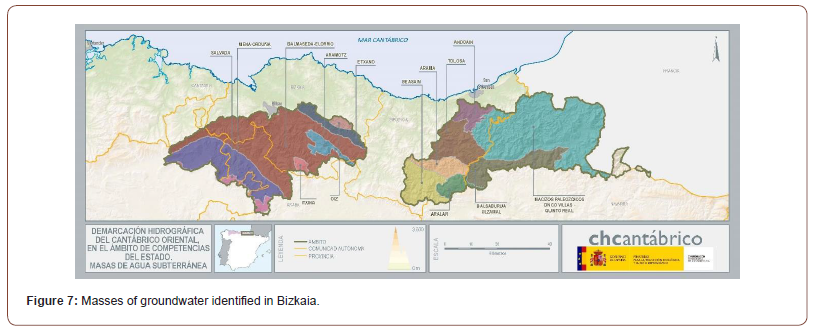
The Autonomous Community of the Basque Country has some competencies transferred from the Spanish Government to the Basque Government. The management of water is one of them. This way, this responsibility relies on the Basque Agency of the Water (Uraren Euskal Agentzia-Agencia Vasca del Agua). This institution provides the same inventory in its webpage [16] and also in its monitoring reports [17].
Additionally, the Energy Agency of the Basque Government (Energiaren Euskal Erakundea-Ente Vasco de la Energía) included in its foundation basis [18] and in its first compiled reports [19,20] the groundwater as a resource, as long as some of the Hydraulic Power Plants located in Bizkaia are underground power plants. This is the case, for instance, of Barazar Hydraulic Power Plant [21].
Finally, the Regional Council of Bizkaia (Bizkaiko Foru Aldundia- Diputación Foral de Bizkaia) published in 2009 one monographic report related to the aquatic environment [22]. This report, that was requested to Anbiotek [23], indicated the low quantities of groundwater in the region, which corroborates the previous studies.
Conclusion
It can be concluded that the volume of groundwater available in Bizkaia is very scarce and it has little usefulness. In spite of the availability of the groundwater that is registered, according to the information that has been gathered, the total available volume of groundwater is little and cannot be quantified. Therefore, if the province of Bizkaia needs a bigger volume of water for the different uses, it looks sensible to increase the quantity of the water transfers or even incorporate desalination as a freshwater resource so as to get the necessary water inventory.
Acknowledgement
The authors would like to thank the Water Hall “CABB” (The Bilbao Bizkaia Water Consortium (CABB, in Spanish), a Business Hall located at the Faculty of Engineering, Bilbao, where data to make this revision related to energetic generation along the water supply system of Greater Bilbao were available.
Conflict of Interest
No conflict of interest.
References
- https://dozzasecondafspagnolo.blogspot.com/p/fotos.html
- https://www.embalses.net/provincias.php
- http://atlasnacional.ign.es/wane/Clima#/media/File:Espana_Precipitacion-media-anual_1981-2010_mapa_13480_spa.jpg
- https://www.bizkaia.eus/home2/Temas/DetalleTema.asp?Tem_Codigo=2408&Idioma=CA&msclkid=7fc1e8febcc611ec88788e3d28c7439d
- Legarda F, Alegría N, Peñalva I, Silveiro A (2021) Water Supply in Greater Bilbao. Adv in Hydro & Meteorol 1(1): 1-4.
- https://www.busturialdekoura.com/es/komunikazioa/urdaibaiko-hornikuntza-lee-partaidetza-prozesua/?msclkid=f3ea35fdbcc611ec9c8a457e51b9410d
- Estudio de Disponibilidad de recursos y compatibilidad de usos del acuífero de Oiz. VOLUMEN-1. MEMORIA FINAL. EVE. JULIO 2001
- https://info.igme.es/cartografiadigital/tematica/Hidrogeologico200.aspx?msclkid=c49a2639bcc711ec9f194499fcd0ce
- https://info.igme.es/cartografiadigital/tematica/Hidrogeologico200.aspx
- MapasIGME - Portal de cartografía del IGME: Mapa Hidrogeologico de España a escala 1:200.000
- http://info.igme.es/BDAguas/
- https://www.arcgis.com/index.html
- https://igme.maps.arcgis.com/home/webmap/viewer.html?webmap=036292dc5b8946bd979a7dc47d2f8561
- https://igme.maps.arcgis.com/home/webmap/viewer.html?webmap=da8eb570845b41bbb5548c8266eaed0d
- https://www.chcantabrico.es/organismo/las-cuencas-cantabricas/marco-fisico/hidrologia?msclkid=08d582aebccd11ec83fcf1af57ec1a49
- https://www.uragentzia.euskadi.eus/hidrografia-de-las-aguas-subterraneas-de-la-capv/webura00-contents/es/?msclkid=1f3a5d1cbcce11ec9450999bd5584316
- https://www.uragentzia.euskadi.eus/contenidos/informacion/seguimiento_ultimos_informes/es_def/adjuntos/T431_06_Sintesis_2020_ES.pdf?msclkid=cc1829fbbcce11ec8e244f8b12cd8ccd
- https://eve.eus/CMSPages/GetFile.aspx?guid=45f503ea-5963-48b9-bd55-1a7cd25c67fd
- https://eve.eus/CMSPages/GetFile.aspx?guid=5be7e8b5-7469-4c05-9ba5-4fa3da803133
- https://eve.eus/CMSPages/GetFile.aspx?guid=a5cafcba-42fe-4b2c-9d85-d76e289788a7
- Alegría N, Peñalva I, Silveiro A, Pinto C, Legarda F (2021) Energy Generation Along the Water Supply in Greater Bilbao. Adv in Hydro & Meteorol 1(2): 1-5.
- https://www.bizkaia.eus/home2/Archivos/DPTO9/Temas/Pdf/El%20medio%20acu%C3%A1tico%20en%20bizkaia.pdf?hash=f3426a89ac37e8d33de97758e1f6f248&mscl/kid=cb500ea1bcde11ec81e183e1b082d90e
- https://www.anbiotek.com/
-
Alegria N*, Penalva I, Silveiro A, Pinto C and Legarda F. Hydrogeology in Bizkaia: A study case. Adv in Hydro & Meteorol. 1(2): 2022. AHM.MS.ID.000509.
-
Groundwater, Hydrogeology, Aquifer, Water transfer, Natural spring, Desalination, Orography, Water storage
-

This work is licensed under a Creative Commons Attribution-NonCommercial 4.0 International License.



